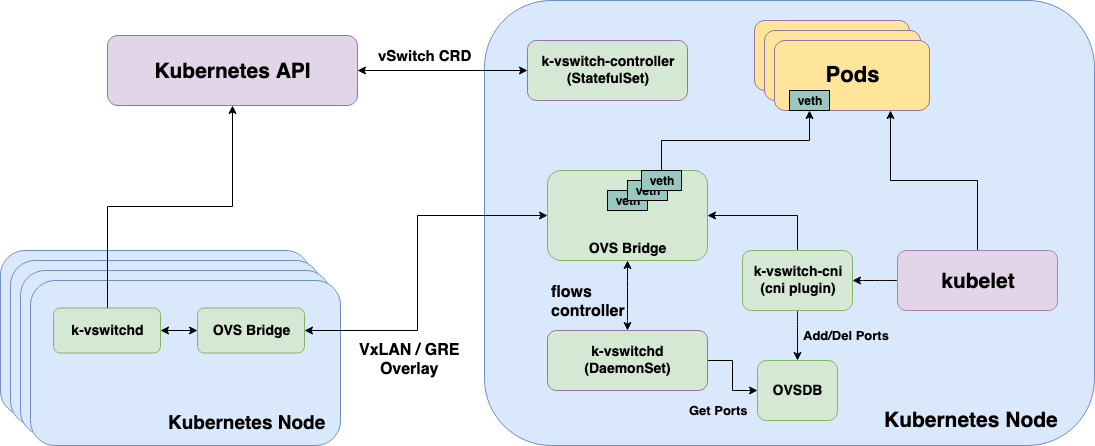k-vswitch / K Vswitch
Programming Languages
Labels
Projects that are alternatives of or similar to K Vswitch
k-vswitch
k-vswitch is an easy-to-operate, high performance and secure Kubernetes networking plugin based on Open vSwitch.
WARNING: k-vswitch is in active development and is not advised for production environments. There will be a production-ready release in the future.
Table of Contents
Why use k-vswitch?
Easy to Operate
k-vswitch was designed to be really easy to install and configure on any Kubernetes cluster. The only installation requirement is that OVS (Open vSwitch)
is installed on every Kubernetes node (i.e apt install openvswitch-switch). Once OVS is installed, k-vswitch should be one kubectl apply away from working
on your cluster. See Installation for more details.
Network Policies
k-vswitch supports Kubernetes Network Policies by programming flows on Open vSwitch. Flows match against ingressing/egressing packets from pods and will only allow packets as specified by the network policy API.
High Performance
k-vswitch is performant by nature due to the Open vSwitch Kernel Datapath. The "fast-path" kernel module allows the kernel to cache subsequent packets in kernel-space, significantly increasing performance compared to the standard Linux bridge, especially in high throughput environments. You can learn more about OVS performance in this blog post or the OVS white paper.
GRE / VxLAN Overlay
k-vswitch supports a simple GRE or VxLAN overlay for your cluster network.
ARP Responder
k-vswitch programs flows on the OVS bridge to automatically send ARP replies to all ARP requests on your pod network. This removes the need for L2 broadcast/learning for pods on your cluster.
See Upcoming features for a list of future improvements/features planned for k-vswitch.
Architecture
Components
k-vswitch has 3 core components:
k-vswitch-cni
k-vswitch-cni is a CNI implemenation based on OVS. It receives a pod's network namespace from the kubelet, creates a veth pair with one end being the pod network namespace
and the other as a port on the OVS bridge. Port information for a given pod is then automatically stored into ovsdb-server (automatically installed with Open vSwitch)
so that k-vswitchd can fetch information about the OVS port later.
k-vswitch-cni is automatically installed and setup by k-vswitchd at startup. More on k-vswitchd below.
k-vswitchd
k-vswitchd runs as a Kubernetes DaemonSet on your cluster, it is responsible for:
- Installing and configuring
k-vswitch-cnion the node - Configuring the OVS bridge (
k-vswitch0) and adding the necessary interfaces/routes associated with the bridge on the host. - Programming flows on the OVS bridge based on the state of the cluster by watching the apiserver for pods, network policies and the
VSwitchConfigCRD (more on this below).
k-vswitch-controller
k-vswitch-controller is a StatefulSet (with repliacs=1) responsible for managing the VSwitchConfig CRD. The VSwitchConfig CRD is responsible for holding information
required by k-vswitchd in order to configure the OVS bridge. There should always be 1 VSwitchConfig object associated with a node in your cluster. The name of the VSwitchConfig
resource should equal the name of the node.
As of today, the VSwitchConfig resource holds the following information:
- cluster CIDR - the pod networking CIDR for the entire cluster
- pod CIDR - the pod CIDR allocated to this specific vSwitch/Node
- service CIDR - the service proxy CIDR on the cluster
- overlay type - the overlay protocol to use,
vxlanorgre - overlay IP - the private address on the node to use for the overlay tunnel
The motivation behind the VSwitchConfig CRD is to consolidate all the necessary information for an OVS bridge into a single resource. This significantly simplies
the controllers running in k-vswitchd and the number of places that requires user input. Some of the above however, (like cluster CIDR) require user input,
more on this in Installation.
Architecture Diagram
Installation
A large focus on k-vswitch's design is ease of use and installation. If you find that k-vswitch is hard to operate and install, please file an issue and offer your feedback!
Requirements
OVS Installed on Kubernetes Nodes
The only install requirement for your cluster is that every Kubernetes node has Open vSwitch installed. Depending on your Linux distribution, you can install it in the following ways:
# debian / ubuntu
$ apt-get install openvswitch-switch
# or...
$ apt install openvswitch-switch
# fedora / centos / RHEL
$ yum install openvswitch
# or...
$ dnf install openvswitch
kube-controller-manager IPAM enabled
Ensure that the kube-controller-manager is configured to allocate pod CIDRs for your nodes. You can enable this by setting the
--allocate-node-cidrs=true flag and a cluster CIDR using the --cluster-cidr=<your-cluster-cidr> flag.
If you are using kubeadm, you can enable this functionality with:
$ kubeadm init --pod-network-cidr=<your-cluster-cidr>
Install Steps
k-vswitch requires the following cluster parameters before it can be installed:
-
cluster CIDR: this is the same cluster CIDR you configured on various components of your cluster via
--cluster-cidr. -
service CIDR: this is the same service CIDR you configured on the
kube-apiservervia--service-cluster-ip-range. -
overlay type: this is the overlay type to use, currently
vxlanandgreare supported.greis recommended but some cloud providers may not support it in which case you can usevxlan.
Once you have the following parameters, you can download the latest deployment spec. The first resource on the deployment spec should be a ConfigMap. Update the ConfigMap fields based on the above parameters and apply it to your cluster:
$ curl -LO https://raw.githubusercontent.com/k-vswitch/k-vswitch/master/deployment/k-vswitch-latest.yaml
$ vim k-vswitch-latest.yaml # edit the first ConfigMap on this file based on your cluster configuration
$ kubectl apply -f k-vswitch-latest.yaml
Upcoming features
k-vswitch is in active development with the following features planned for the near-future:
- Native Pod Routing - integrate with kube-router to do BGP native routing to pods along with k-vswitch (i.e. no overlay)
- Service Proxy - implement kube-proxy like load balancing for Kubernetes Services via OpenFlow
- Pod Traffic Telemetry - traffic telemetry for pods using sFlow on Open vSwitch
- Windows support - k-vswitch is currently only supported on Linux. Since OVS supports Windows, k-vswitch may support it in the future.

